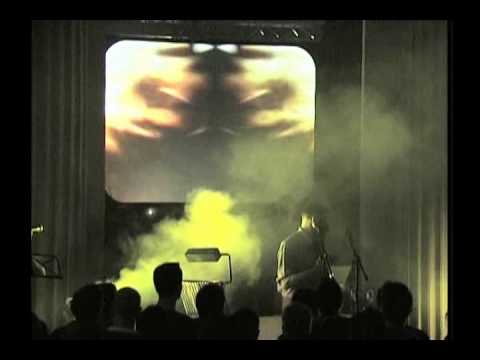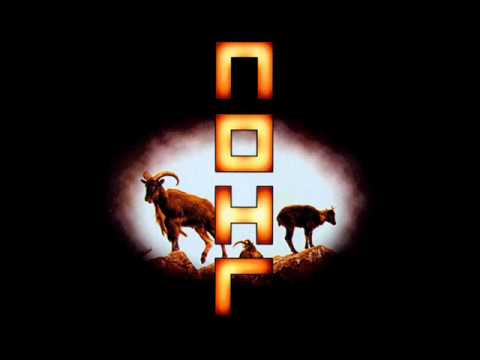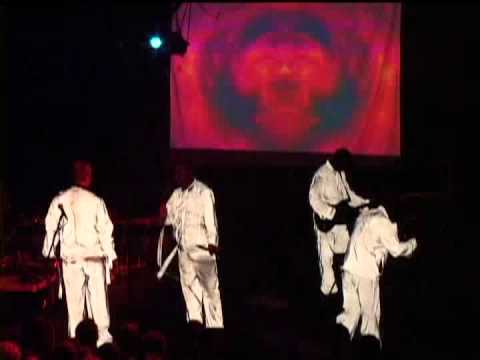“COIL know how to destroy Angels. How to paralyse. Imagine the world in a bottle. We take the bottle, smash it, and open your throat with it. I warn you we are Murderous. We massacre the logical revolts. We know everything! We know one thing only. Absolute existence, absolute motion, absolute direction, absolute Truth. NOW, HERE, US.” Excerpt from the Coil Manifesto, 1983
Through a potent trinity of chemically-altered states, occult arcana and technological transmutation, Coil was perhaps the strangest and occasionally the most frightening of bands. While their twenty year history saw much in the way of personal turmoil and tragedies as they moved through the extreme hedonism and post-AIDS fallout of London’s gay clubland to a more hermetic but no less intoxicated existence on England’s South West coast, John Balance (née Geff Rushton) and Peter ‘Sleazy’ Christopherson remained true to their original intentions to explore, as the cover of their debut release puts it: “How sound can affect the physical and mental state of the serious listener”. Such explorations produced a unique and incomparable body of work that not only charts a most unconventional route through emergent musical technologies, but also signposts a hellishly complex set of references to occult theories and deviant figures throughout history (from Aleister Crowley to William S Burroughs) along the way. But the high physical and mental cost of their creative processes often led to long gaps in their output. Indeed, the most elusive album in their back catalogue eluded the band themselves: Backwards, originally intended as a follow-up to 1991’s Love’s Secret Domain, was mentioned in the band’s semi-regular updates describing sessions with mainstream players such as Tim Simenon and Trent Reznor, yet the album was never released (although some of the recordings were later re-arranged posthumously for The Ape of Naples and its companion piece, The New Backwards).
Viewing things backwards, or from a different angle, represents the very essence of Coil. They referred to their music as sidereal sound, its double meaning of astrological time and a sideways perspective neatly encapsulating their mission to seek out the hidden mechanisms of the universe through unconventional practice. In celebration of this, here we take a trip through Coil’s marvellous mystical music, but in a direction that is at once both illogical yet somehow wholly suitable for such an uncompromising and unusual band – backwards!
Going Up
By the time of John Balance’s accidental death from a drunken fall in 2004, Coil’s timeline plotted an inverted trajectory compared to the typical band model. Instead of developing a sound through playing venues of increasing sizes creating a groundswell of interest before graduating to the studio, Coil remained largely studio-bound for their first 17 years, finally taking their show on the road in 2000. Their last concert was at the 2004 Dublin Electronic Music Festival where, as had been customary over the past four years, they played a set full of new songs to an always intent and captivated audience. It ended with ‘Going up’, sung by guest François Testory, at first sounding like a celestial hymn that operatically emotes a mournful yet jubilant journey after death. Also sung at Balance’s funeral, it went on to close the Ape Of Naples album, completed by Christopherson immediately after Balance’s death, making one of the album’s many moving yet eerily coincidental references to dying and the beyond. But upon closer inspection the track is a preposterous cover version of the theme from the camp, British sitcom Are You Being Served?, the lyrics referring to descriptions of what’s in store on different floors while ‘going up’ in the elevator. Coil had turned base matter into gold one last time.
Remote Viewing I
Despite the rigours of touring, this final phase of Coil was arguably their most productive in terms of releases, which they often sold in limited quantities at their concerts rewarding their loyal fans. With Backwards still remaining on the backburner they set themselves the task of defining a new set for each tour that, with its very real deadlines, always helped them produce recordings often formed from rehearsals and jams in preparation for the shows. Sleazy and Balance being proud non-musicians, this was in part thanks to the guests they recruited to help them perform live, each weaving their own signature sounds around Christopherson’s pre-recordings creatively directed by Balance. The Remote Viewer was just one of the five or six albums they made in this way, sold on a tour of Europe in 2002, and showcases the delicious and mesmerising tones of Mike York’s Breton pipes and Cliff Stapleton’s hurdy gurdy as they brought Coil’s prepared percussive psychedelics to life.
Constant Shallowness Leads to Evil
Perhaps the most significant addition to this late-period Coil was Thighpaulsandra, poached from fellow space-travellers Julian Cope and Spiritualized, who first persuaded Sleazy and Balance that playing live was a very real possibility. A classically-trained musician and analogue synth fetishist (among other kinks), Thighpaulsandra has since suggested that touring with Coil was “the best of times and the worst of times”. The latter presumably referring to the combustible energies of Balance that lead to him going missing through “alcohol driven psychotic episodes”, as Sleazy later described them, requiring the others to perform without him in 2003. But three years’ earlier they really were a potent combination, firing on all cylinders as they delivered their second sensational show of the year at London’s prestigious Royal Festival Hall with a set that culminated with ‘Constant Shallowness Leads to Evil’, the most ferocious and frightening yet compelling and consuming of Coil’s performances. Dressed in what seemed like soiled straightjackets, the four shaven headed men stalked the stage sporting bloodied bruises on each of their heads (although only Balance’s black eye was real, apparently) as they climaxed angrily with wave after intense wave of gnarled electronics as the hypnotic backdrop quoted Captain Beefheart in a blipvert flashing “God please fuck my mind for good”.
Shortly before the concert John Balance explained to Pure magazine: “It’s some of the most aggressive music I’ve ever heard, but it’s rich and flowing… We’re working with these huge modular synthesisers… and we patch them all together to create these massive circuits, to make a real wall of sound. In the live show, Thighpaulsandra really excels at this, intuitively re-wiring all the circuits, while we move around him telepathically. I’m not being facile here, it really is into the realms of telepathy when every movement you make on stage sends new patterns into the sound."
Are You Shivering?
A couple of years’ before their live incarnations, Balance and Sleazy had escaped London where they’d both lived together since the early eighties, moving to a nineteenth century boys’ school overlooking the Bristol channel. The urban to rural move is said to have catalysed the development of a lunar aspect to their music. As Balance told Wire magazine in 2000: “The overall Coil symbol was the black sun, and we’ve deliberately decided to go from solar to lunar aspect. We just decided to become completely open to whatever happens: make more reflective music. It seems a logical step… moon music.” ‘Are You Shivering?’ is the first track from the first volume of Music To Play In The Dark which was the first album to be recorded in their newly built home studio. It reveals a calmer, more ordered and sensitive Coil sound that attracted new fans previously deterred by the assumed machismo of the Industrial scene that birthed the band. Its portentously stormy opening gives way to further organic electronics suggesting rain drops and a crackling camp fire with a decidedly woozy treated vocal as Balance unhurriedly narrates an ecstatic tale of bukkake and the lunar body.
Time Machines
Even before the move to the sea Coil were showing signs that change was on the horizon. They had come up with a strategy to record more spontaneously, provoking real time improvisations begun at the precise time of the solstices and equinoxes of 1997 that were then swiftly released as a series of seasonal EPs. While the results surprised many fans with their folky infusions, the following year’s Time Machines album was to become the most starkly startling and arguably opened the drone floodgates that continue to be awash today. Formed of four extended modular synth tones, the album aspired to “cure you of time”. As Balance explained in England’s Hidden Reverse, David Keenan’s book about the band and their close friends Current 93 and Nurse With Wound: “In the sense that time is an affliction, everything is speeding up and there’s no time and everything is compressed. Your time isn’t your time anymore… Time Machines was an attempt to create a space where people can stop and have gaps.” Influenced by La Monte Young’s explorations of frequency relationships, the four tracks are each attributed to psychoactive substances where, legend has it, members of the band “calibrated” the emerging sounds with a whole range of different drug trials to optimise the timeless effect.
Red Skeletons
In a way, Time Machines can be viewed as the last in a short series of projects that formed a kind of nervous interim period before coastal life reconstituted their mettle once more. Like Time Machines, their output throughout the mid-nineties refused to bear the Coil name, perhaps in diffidence as a means of protecting it from their experiments that were finding confluence with other acts artfully escaping the dance music tags of the time, like Autechre and Scanner. Their 1995 album Worship The Glitch was attributed to ELpH, the name they gave for the invisible presence they felt was infecting and directing the highly abstract concrète emerging from the studio, and the following years’ A Thousand Lights In A Darkened Room was presented under the guise of Black Light District which they described as having “a Subterranean earth-tree-dreamers perspective”. Like a lot of their music at the time, ‘Red Skeletons’ is sparse and paranoid, evoking pulsing machines that steadily deteriorate and reform in textural suggestions of faltering radio technologies as tinny recordings of telephone conversation bleed through voyeuristically.
First Dark Ride
‘First Dark Ride’ is representative of a period when affordable technology, having created studios out of bedrooms, suddenly offered artists more choice than ever before with which to trigger, bend and sculpt their sound. Such choices were the food on which Christopherson loved to graze, reportedly spending many a sleepless night getting under the skin of a new plug-in or bit of kit before auditioning the results to Balance in the morning. Consequently, we can observe in ‘First Dark Ride’ a bewildering array of ideas that would go on to be re-cycled and re-developed on numerous future releases as Sleazy refined his approach. It’s hallucinatory music box winds down to macabre, stretched vocals followed by tribal drumming over a sample of Charles Manson rambling, all of which merely serves as a seven minute intro to an up-tempo acid trance wig out!
Dark River
Released in 1991, Love’s Secret Domain was Coil’s most heavily publicised album and one in which the energies that went into its recording almost destroyed the band following a couple of lost years in which Sleazy and Balance immersed themselves in the ecstasy-fuelled underground club scene. While the record does reflect some of the sounds of that era, with the chosen singles ‘Windowpane’ and ‘The Snow’ bearing similarities to The Beloved or The Future Sound of London, the rest of it is a full spectrum tour-de-force of electronic experimentation that sits classical minimalism alongside full-bodied cabaret songs all twisted under dense layers of corrupting sample fragments. ‘Dark River’, though, is a deceptively simple instrumental that shows the exquisitely elegant side of Coil productions, unshy of employing gorgeous melodies and rich arrangements to directly affect its listeners without losing its otherworldly charms. As Stephen Thrower (a key member of the band since 1984 who left soon after the recording of the album), recently recalled to Brainwashed: “During ‘Dark River’ we spent literally as much time rolling around on the floor under the desk as we did hovering over the controls… The desk automation was faulty, so that one was a bloody nightmare – it probably took about forty passes… After each effort me and Geff would collapse to the studio carpet and go and live with the fluff babies for a while.” The sessions for the album have since taken on mythical status with band members reporting shared visions of entities crowding the studio, from Babylonian kings and holy men to Aztec and Amazonian warriors, as their drug taking reached a landmark peak.
Ostia (The Death Of Pasolini)
Taken from their second album, Horse Rotorvator released in 1986 and still a firm favourite among their more long-term fans, ‘Ostia’ exploited the then new Emulator sampling technology allowing Sleazy to blend synthetic strings with live ones to arrive at the sumptuous baroque orchestrations that cropped up frequently throughout their earlier recordings. The song itself is a prime example of Balance’s complex conceptual layerings – as he put it himself in 1990, “‘Ostia’ is a tribute to a friend of ours who passed away… Dover came into the picture because another friend of ours jumped over the cliffs. And this brings in the subject of beaches. Pasolini was murdered on the beach of Ostia. Ostia means sacrifice, in English it means a bone; The mixing of places. Pasolini comprehended his own death, I think he wanted to die the way he did. "
The beautiful video presented here was directed by Christopherson in 2008, whose ‘day job’ as a video director, often for contemporary pop and rock stars, supported Coil’s many inactive phases. It was made in Thailand where he lived from 2005 until his equally unexpected death in his sleep last year.
How to Destroy Angels
Balance and Sleazy first met through the former’s fanaticism for Throbbing Gristle. TG was the group in which Christopherson first experimented with electronic sound, along with Chris Carter, Cosey Fanni Tutti and Genesis P-Orridge as they pioneered a new form of music. After TG terminated its mission their partnership strengthened in Psychic TV where they joined the remarkably long-lived roster at Some Bizarre records that included Soft Cell and Foetus making life long friends and frequent Coil collaborators out of Marc Almond and Jim Thirlwell along the way. But, after a couple of years, Balance and Sleazy felt their positions in PTV to be untenable as its original intentions to demystify control mechanisms while promoting self-reliance and creative individualism were eclipsed by the usual rockist trappings of hero worship. Their first release was, arguably, their most overtly ritualistic, formed of just twelve gongs and a couple of bullroarers, its front cover describing the intent: “…we have tried to produce sound which has a real, practical and beneficial power in this modern Era. Specifically, it is intended as an accumulator of male sexual energy… The execution of the piece was structured around concepts that we felt would work for us, in this case magickal and numerological rather than conventionally musical in form…”
Clearly Coil’s intentions remained remarkably true to this original vision, endowing the world with music that while strange still overshadows the more frighteningly wild and chaotic lifestyles of its creators. John Balance and Peter Christopherson’s passing means that modern music has become that bit straighter, safer and more sanitised than when they were alive, leaving us with a responsibility to remember their legacy – to quote Horse Rotovator’s run-out groove – the responsible abuse of pleasure.





